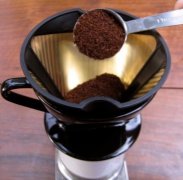Detailed analysis of low molecular weight sugars in coffee beans

Moisture:
The water content of coffee beans varies greatly with different processing stages and products. The moisture content of wet coffee beans with film is about 50%, while that of dried raw coffee beans is about 10%-13%, and that of roasted coffee beans is only less than 5%. The existence of water in coffee beans, like other kinds of food and beverages, contains a considerable amount of hydration colloidal macromolecules, such as proteins and polysaccharides, so that water exists in coffee beans in many different physical and chemical ways.
Minerals:
Although the content of minerals in coffee beans is small, accounting for about 4% of the dry weight of raw coffee beans, it is very important. It contains many different elements, of which potassium is the most, accounting for about 40% of all minerals, followed by calcium, magnesium, phosphorus, sodium and sulfur. There are many other trace elements at the PPM level, such as zinc, manganese, copper, rubidium and so on. The minerals in coffee beans can not be used to express the content of coffee or coffee powder products, the latter have water addition in the preparation or processing process, which will be affected by the water quality and produce different changes. In addition, the most important factors affecting the mineral content and species of raw coffee beans are soil and fertilization in the process of cultivation. During the preparation of coffee, at least 90% of the minerals can be extracted from roasted coffee beans, so the relationship between the content of potassium or other minerals and the yield of coffee soluble can be used to evaluate the extraction rate of coffee.
Carbohydrates:
The carbohydrates in coffee beans can be divided into polysaccharides and low molecular weight sugars, which contain carbohydrates such as monosaccharides, disaccharides and trisaccharides. In addition, it can be divided into reducing sugar and non-reducing sugar. It also contains some derivatives, such as glue, etc. The contribution of carbohydrates to coffee lies in its taste, aroma and color. In terms of flavor, carbohydrates will not only emit coffee aroma after roasting, but also absorb volatile aroma, making coffee show a special flavor.
Low molecular weight sugars:
Sucrose is the most important free sugar in raw coffee beans, and its content varies according to variety, source and maturity. Generally speaking, Arabica coffee beans contain more sucrose than Robusta coffee beans, and other simple sugars, including reducing sugars, can also be detected in the extract of raw coffee beans. Raw coffee beans also contain glucose and fructose, the content of Arabica is lower than that of Robusta, and the total reducing sugar of Arabica is also lower than that of Robusta.
After roasting coffee beans, the changes of low molecular weight sugars vary according to the degree of roasting, the loss of sucrose is the fastest, the loss rate of light roasting is 97%, moderate roasting is 99%, heavy roasting is 100%. Others, such as glucose, fructose and arabinose, also have considerable losses.
Polysaccharides:
Polysaccharides are very important components in raw coffee beans, accounting for about 40% ~ 50% of dry matter. According to the type, there are polygalactose, polyicoses, polyarabinose and cellulose, which are the substances that make up the plastids of coffee beans and are related to the hardness of coffee beans.
After roasting, polysaccharides will still be preserved in a considerable amount. According to the data obtained from a study, it is found that there is not much difference among different roasting degrees, and the retention rate is between 70% and 75%, among which the retention rate of cellulose is the highest and that of polyarabinose is the lowest. In terms of extraction, some polysaccharides will be extracted, depending on the type of solvent. When extracted with water, more polysaccharides are extracted from arabinose, galactose and some mannose.
Organic acids:
When making coffee, the performance of acidity is very important. under good conditions and skills, a special taste with fresh acidity can be developed, which is a necessary condition for high-grade coffee. Generally speaking, the more deeply roasted coffee beans, the less sour development, or even none, and show another kind of pure coffee characteristics.
Non-volatile acids in raw Arabica coffee beans include citric acid, malic acid, oxalic acid and tartaric acid. After testing, a large number of volatile acids were not found. When raw coffee beans are roasted, the content of acid changes greatly, among which the change of volatile acid is the biggest. After roasting, the loss rate of acid in raw beans is about 15%, and what is more noteworthy is the chemical change of acid. Formic acid and acetic acid increased at the initial stage of roasting, and increased with the increase of roasting degree. Until the end of roasting, citric acid and malic acid showed a decreasing trend, while citric acid and malic acid decreased gradually to form their decomposition products.
Proteins and amino acids:
In terms of crude protein, the content of raw coffee beans is about 13% ~ 16%. If nitrogen compounds such as caffeine and trigonelline are deducted, the real protein content is about 8.8% to 9.7%. Raw coffee beans also contain a variety of enzymes, such as lipopolytic enzymes, proteolytic enzymes, carbohydrate hydrolytic enzymes, galactose hydrolytic enzymes and peroxide enzymes. Raw coffee beans contain about 0.15% ~ 0.25% free amino acids, and the content of Robusta is higher than that of Arabica. These free amino acids have a higher effect on coffee flavor and less effect on coffee taste.
Chlorogenic acid (chlorogenic Acidss):
Chlorogenic acid has at least three isomers, and its function mainly lies in the physiological regulation of coffee plants, including promoting growth, rhizome formation, antibacterial, prevention of diseases and insect pests and chemotaxis before becoming lignin. In raw coffee beans, the content of Robusta is higher than that of Arabica, and the content of wet processed raw coffee beans is about 40% lower than that of dry processing. After roasting, it will disappear through different functions, resulting in extremely complex products, which are closely related to the quality of coffee.
Fat:
The fat of raw coffee beans is composed of coffee oil (Coffee Oil) in the endosperm and wax in the outer layer of coffee beans. Coffee oil not only contains triglycerides, but also contains equivalent other fat components. It forms the characteristics of coffee, which is very important for coffee.
The coffee oil content and composition of raw coffee beans vary according to different varieties. According to many studies and statistics, the average content of Arabica coffee beans is 15% of dry matter, and the standard deviation is 0.78%. The standard deviation of Robusta coffee beans is 10%, and the standard deviation is 1.41%.
Volatile substances:
Volatile compounds are the main source of coffee flavor, which is especially important for coffee quality. There are many kinds of volatile substances in coffee, and their existence will affect the aroma quality of coffee. Its main source is derived from non-volatile substances in raw beans which are disconnected or derived after reaction in the process of roasting. The aroma and flavor of coffee are formed as a result of thermal decomposition, other reactions or compositions, such as sugars, amino acids, organic acids and phenolic compounds. The factors affecting the volatile components of coffee include the variety of coffee beans, cultivation climate, soil conditions, preservation of raw beans, roasting temperature and time, roasting equipment and so on.
Raw coffee beans do not contain the special aroma of coffee, so they are not eaten directly and must be roasted before a large number of volatile aroma compounds are produced. After roasting, there are at least 660 kinds of main volatile aroma components in raw coffee beans, which is the food with the largest variety of volatile aroma components in all foods and beverages. The aromas produced in the process of roasting, such as hazel, cream and caramel, or with grass, smoke, burning, spice and bitterness, are mostly from volatile substances. In addition, the difference of roasting degree will also affect the flavor characteristics of coffee.
Pectin and lignin:
Pectin is a substance composed of a variety of polysaccharides, which is mainly composed of galactoic acid polymer, rhamnose and so on, with a content of more than 3%. Lignin is the insoluble residue left after the plant is treated with sulfuric acid and caustic alkali, that is, the so-called coffee fiber, with a content of about 2.4%.
Nitrogenous compounds:
The nitrogenous compounds in raw coffee beans can be divided into plant alkaloids, trigonelline (Trigonelline), nicotinic acid, protein and free amino acids.
1. Plant alkaloids:
It is mainly caffeine (Caffeine). The content of caffeine in raw coffee beans varies greatly from variety to variety. The content of Robusta is higher, the average content is about 2.2% of the dry matter, the content of mineArabica is less, the average content is about 1.2%. In recent years, low-caffeinated coffee beans have been cultivated in Java and C ô te d'Ivoire, with a caffeine content of only 0.2%. Caffeine can be removed by a variety of methods to make a variety of decaffeinated products. The caffeine content of decaffeinated instant coffee powder is less than 0.3%, and general commodities are controlled between 0.1% and 0.2%. Caffeine can be said to be the spirit of coffee, but also the most controversial issue.
Although caffeine has no odor, it has a remarkable bitter taste. Although some people want to judge the amount of caffeine by the same degree of bitterness of coffee, it is not completely successful, because the bitterness of caffeine accounts for only a small part of the bitterness of coffee, so there is not much influence on the bitterness of decaffeinated coffee.
After being digested by the human body, caffeine can be quickly absorbed and metabolized and excreted in the urine. The increase of caffeine in human blood depends on the content in the stomach. The most significant physiological effect of caffeine on the human body is the stimulation of the central nervous system. As for the dose required for changes in brain activity, which is much higher than the normal intake, other physiological effects that attract people's attention are the effects on blood pressure, the direction of the heart and blood vessels.
2. Trigonelline (Trigonelline):
Trigonelline is a colorless crystal with hygroscopicity and excellent solubility in water. it also has a low degree of physiological effects, mainly for the central nervous system, bile secretion and intestinal peristalsis. The direct effect of trigonelline on the quality of coffee is very small, its bitter taste is only 1/4 of caffeine, because its existence is very small, so it has little effect on the taste. The content in raw coffee beans varied with different varieties, and the content of Arabica was higher than that of Robusta. Trigonelline decomposes quickly in the process of roasting, and its loss rate is about 50% ~ 80%, which varies according to the roasting temperature and time. In addition, trigonelline breaks down to form a variety of compounds, including non-volatile nicotinic acid. And 29 kinds of volatile compounds, among which 9 kinds of coffee aroma compounds have been identified.
3. Nicotinic acid:
The content of nicotinic acid in raw coffee beans is very small, but it increases after roasting, mainly because it comes from the decomposition of trigonelline. But the results show that nicotinic acid continues to decompose into volatile chemicals at high roasting temperatures, so the real increase is not much.
Important Notice :
前街咖啡 FrontStreet Coffee has moved to new addredd:
FrontStreet Coffee Address: 315,Donghua East Road,GuangZhou
Tel:020 38364473
- Prev

The standard brewing ratio of coffee to water.
(figure Source: google) Standard brewing ratio (Standard Brewing Ratio) number of coffee cups the amount of coffee used by COFFEE TO BE USED WATER TO BE USED Cups of Coffee by weight BY WEIGHT BY MEASURE ounces Ounces grams Grams teaspoons Tea tablespoons Table cups Cups coffee liquid (ounces) Cu
- Next

Al's Rule's Rule Sweet Point Formula of Espresso extraction
Al Critzer's understanding of Espresso extraction has become the most common concept of Espresso in Europe and the United States. The translation is as follows: starting with the result that 30cc/ 30sec gets a perfect Espresso. These two values of course depend on beans, and the differences in baking method, baking degree and formula ratio will naturally lead to changes in the reference point. The extraction quantity and extraction time are mutually related.
Related
- Detailed explanation of Jadeite planting Land in Panamanian Jadeite Manor introduction to the grading system of Jadeite competitive bidding, Red bid, Green bid and Rose Summer
- Story of Coffee planting in Brenka region of Costa Rica Stonehenge Manor anaerobic heavy honey treatment of flavor mouth
- What's on the barrel of Blue Mountain Coffee beans?
- Can American coffee also pull flowers? How to use hot American style to pull out a good-looking pattern?
- Can you make a cold extract with coffee beans? What is the right proportion for cold-extracted coffee formula?
- Indonesian PWN Gold Mandrine Coffee Origin Features Flavor How to Chong? Mandolin coffee is American.
- A brief introduction to the flavor characteristics of Brazilian yellow bourbon coffee beans
- What is the effect of different water quality on the flavor of cold-extracted coffee? What kind of water is best for brewing coffee?
- Why do you think of Rose Summer whenever you mention Panamanian coffee?
- Introduction to the characteristics of authentic blue mountain coffee bean producing areas? What is the CIB Coffee Authority in Jamaica?

